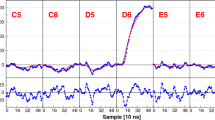Abstract.
For the first time, bases of signals delivered by highly segmented HPGe detectors, for identified hit locations, have been determined in situ, that is in the actual accelerator-target-detection system conditions corresponding to data acquisition during a physics experiment. As a consequence, these bases include all the genuine features and alterations of the signals induced by the experimental setup, e.g. diaphony, electronic response, specificity of individual crystals. The present pulse shape bases were constructed using calibration source data taken at the beginning of the AGATA campaign at GANIL. An experiment performed at GANIL using the AGATA \(\gamma\)-ray detector together with the VAMOS spectrometer was used to validate the bases. The performance of the bases when used for pulse-shape analysis has been compared to the performance of the standard bases, composed of pulse shapes generated by a computer simulation used for AGATA. This is done by comparing the Doppler correction capability. The so-called Jacobian method used to generate the in situ bases also produces correlations that can be applied to locate in a direct way (no search algorithm) the location where a \(\gamma\)-ray interacted given that only one segment is hit. As about 50% of all pulse-shape analysis is performed on crystals with only one segment hit this will allow for a large reduction in the needed computer power. Different ways to improve the results of this prospective work are discussed.
Similar content being viewed by others
References
S. Akkoyun et al., Nucl. Instrum. Methods Phys. Res. A 668, 26 (2012)
I. Lee et al., Nucl. Phys. A 746, 255 (2004)
A. Gadea et al., Nucl. Instrum. Methods Phys. Res. A 654, 88 (2011)
N. Pietralla et al., EPJ Web of Conferences 66, 02083 (2014)
E. Clément et al., Nucl. Instrum. Methods Phys. Res. A 855, 1 (2017)
A. Gadea et al., Eur. Phys. J. A 20, 193 (2003)
J. Simpson et al., Acta Phys. Hung. 11, 159 (2000)
H. Wollersheim et al., Nucl. Instrum. Methods Phys. Res. A 537, 637 (2005)
R. Venturelli, D. Bazzacco, LNL Annual Report (2004) p. 220
B. Bruyneel, B. Birkenbach, P. Reiter, Eur. Phys. J. A 52, 70 (2016)
B. Bruyneel, P. Reiter, G. Pascovici, Nucl. Instrum. Methods Phys. Res. A 569, 764 (2006)
B. Bruyneel, B. Birkenbach, P. Reiter, Nucl. Instrum. Methods Phys. Res. A 641, 92 (2011)
B. Birkenbach et al., Nucl. Instrum. Methods Phys. Res. A 640, 176 (2011)
B. Bruyneel et al., Nucl. Instrum. Methods Phys. Res. A 599, 196 (2009)
A. Wiens et al., Eur. Phys. J. A 49, 47 (2013)
F. Recchia et al., Nucl. Instrum. Methods Phys. Res. A 604, 555 (2009)
P.-A. Söderström et al., Nucl. Instrum. Methods Phys. Res. A 638, 96 (2011)
T. Steinbach et al., Eur. Phys. J. A 53, 23 (2017)
G. Schmid et al., Nucl. Instrum. Methods Phys. Res. A 430, 69 (1999)
F. Recchia et al., Nucl. Instrum. Methods Phys. Res. A 604, 60 (2009)
C. Michelagnoli, in preparation
A. Boston et al., Nucl. Instrum. Methods Phys. Res. B 261, 1098 (2007)
L. Nelson et al., Nucl. Instrum. Methods Phys. Res. A 573, 153 (2007)
T. Ha et al., Nucl. Instrum. Methods Phys. Res. A 697, 123 (2013)
S. Martín, B. Quintana, D. Barrientos, Nucl. Instrum. Methods Phys. Res. A 823, 32 (2016)
F. Crespi et al., Nucl. Instrum. Methods Phys. Res. A 593, 440 (2008)
C. Domingo-Pardo et al., Nucl. Instrum. Methods Phys. Res. A 643, 79 (2011)
N. Goel et al., Nucl. Instrum. Methods Phys. Res. A 652, 591 (2011)
M. Ginsz, Characterization of high-purity, multi-segmented germanium detectors, PhD Thesis, Université de Strasbourg, Ecole doctorale de physique et chimie physique, Institut Pluridisciplinaire Hubert Curien, UMR 7178 CNRS/IN2P3 (2015)
P. Désesquelles et al., Phys. Rev. C 62, 024614 (2000)
P. Désesquelles, Nucl. Instrum. Methods Phys. Res. A 654, 324 (2011)
P. Désesquelles et al., Nucl. Instrum. Methods Phys. Res. A 729, 198 (2013)
Second AGATA-GRETINA tracking arrays collaboration meeting, private communication (2018)
E. Farnea et al., Nucl. Instrum. Methods Phys. Res. A 621, 331 (2010)
N. Lalović et al., Nucl. Instrum. Methods Phys. Res. A 806, 258 (2016)
S. Pullanhiotan, M. Rejmund, A. Navin, W. Mittig, S. Bhattacharyya, Nucl. Instrum. Methods Phys. Res. A 593, 343 (2008)
M. Vandebrouck et al., Nucl. Instrum. Methods Phys. Res. A 812, 112 (2016)
M. Rejmund et al., Nucl. Instrum. Methods Phys. Res. A 646, 184 (2011)
J. Dudouet et al., Phys. Rev. Lett. 118, 162501 (2017)
B. Singh, Z. Hu, Nucl. Data Sheets 98, 335 (2003)
L. Bettermann et al., Phys. Rev. C 82, 044310 (2010)
Y.H. Kim et al., Eur. Phys. J. A 53, 162 (2017)
B. Bruyneel et al., Eur. Phys. J. A 49, 61 (2013)
I. Doxas, C. Nieter, D. Radford, K. Lagergren, J.R. Cary, Nucl. Instrum. Methods Phys. Res. A 580, 1331 (2007)
Author information
Authors and Affiliations
Corresponding author
Additional information
Communicated by C. Ur
Rights and permissions
About this article
Cite this article
Li, H.J., Ljungvall, J., Michelagnoli, C. et al. Experimental determination of reference pulses for highly segmented HPGe detectors and application to Pulse Shape Analysis used in \(\gamma\)-ray tracking arrays. Eur. Phys. J. A 54, 198 (2018). https://doi.org/10.1140/epja/i2018-12636-9
Received:
Accepted:
Published:
DOI: https://doi.org/10.1140/epja/i2018-12636-9




